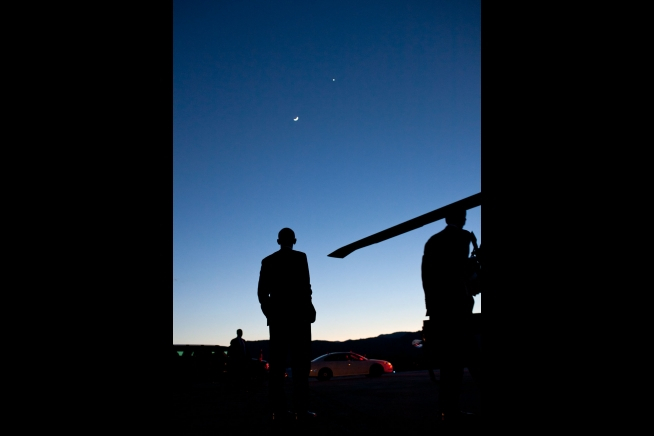President Obama Catches View of Dazzling Venus and Moon

Skywatchers awed by the brilliant planet Venus shining with the crescent moon this week are in good company. The striking celestial lights also drew the watchful gaze of President Barack Obama, a new White House photograph reveals.
The photo of the president with Venus and the moon was captured Tuesday (April 24) at Buckley Air Force Base in Colorado by White House photographer Pete Souza.
Venus is reaching its peak brightness of the year this week and was joined Tuesday by a crescent moon that resembled a bright smile in the sky as it slid by the bright planet.
"President Barack Obama stops to view the moon and Venus before boarding Marine One in Boulder, Colo., April 24, 2012," the photo's caption states on the White House website, which posted the image Thursday (April 26). [See the photo of Obama, Venus and the moon]
Souza's photo shows the president in silhouette admiring the evening twilight, while the crescent moon and Venus shine bright overhead.
The president took in the Venus-moon sight after what appeared to be a long day of cross-country flights that ended in Colorado.
According to his schedule, the president started the day in the White House East Room honoring finalists for the 2012 National Teacher of the Year award. He then flew to North Carolina to deliver remarks on student loans at the University of North Carolina at Chapel Hill, sat down for an interview with TV's "Late Night with Jimmy Fallon," then left for Colorado.
Get the Space.com Newsletter
Breaking space news, the latest updates on rocket launches, skywatching events and more!
Venus is currently the brightest star-like object in the night sky and can easily be spotted about 45 minutes after sunset by skywatchers with clear weather. The planet is so bright that it can even be seen in daylight, if you know exactly where to look. In small telescopes, Venus can be seen going through a series of phases similar to those of the moon.
Venus will continue to appear as a dazzling beacon in the evening sky through May 17. By May 21, however, the planet will be setting before the end of evening twilight.
Later this year, Venus will offer an ultra-rare skywatching treat. On June 5 or 6 (depending on your location), Venus will cross the face of the sun as seen from Earth in what astronomers call a transit.
The last time Venus crossed the sun was in 2004, but the Venus transit of 2012 is special: It is the last Venus transit that will be witnessed by anyone alive today. After this year, the next time Venus will cross the sun will be in the year 2117.
You can follow SPACE.com Managing Editor Tariq Malik on Twitter @tariqjmalik. Follow SPACE.com for the latest in space science and exploration news on Twitter @Spacedotcom and on Facebook.
Join our Space Forums to keep talking space on the latest missions, night sky and more! And if you have a news tip, correction or comment, let us know at: community@space.com.

Tariq is the Editor-in-Chief of Space.com and joined the team in 2001, first as an intern and staff writer, and later as an editor. He covers human spaceflight, exploration and space science, as well as skywatching and entertainment. He became Space.com's Managing Editor in 2009 and Editor-in-Chief in 2019. Before joining Space.com, Tariq was a staff reporter for The Los Angeles Times covering education and city beats in La Habra, Fullerton and Huntington Beach. In October 2022, Tariq received the Harry Kolcum Award for excellence in space reporting from the National Space Club Florida Committee. He is also an Eagle Scout (yes, he has the Space Exploration merit badge) and went to Space Camp four times as a kid and a fifth time as an adult. He has journalism degrees from the University of Southern California and New York University. You can find Tariq at Space.com and as the co-host to the This Week In Space podcast with space historian Rod Pyle on the TWiT network. To see his latest project, you can follow Tariq on Twitter @tariqjmalik.











